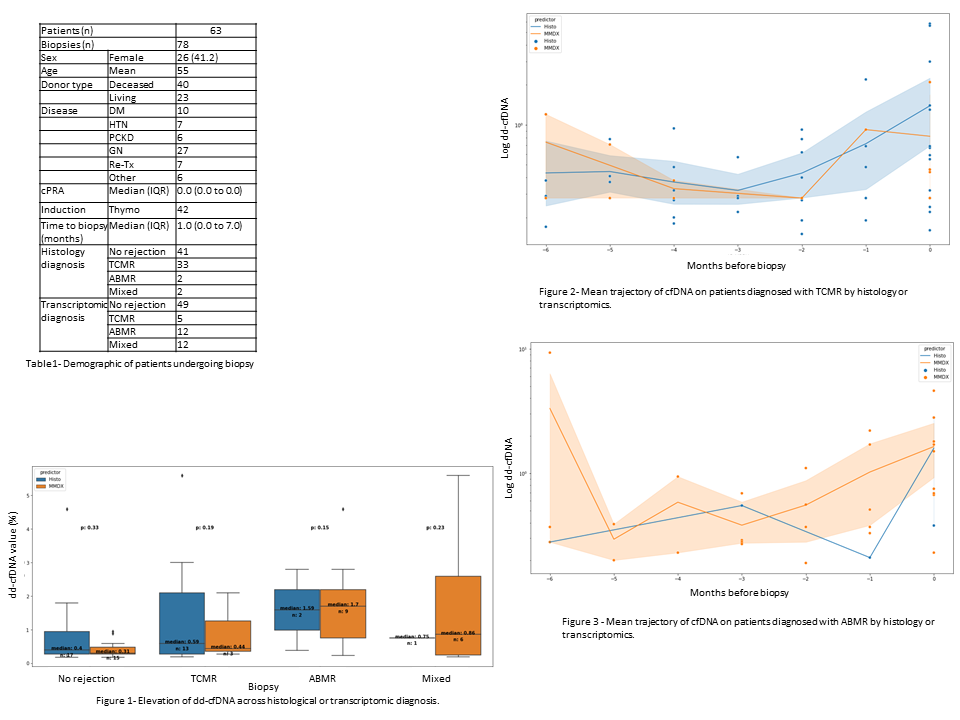Utility of a Holistic Molecular Paradigm for Kidney Biopsy in the Clinic
1Intermountain Medical Center, Murray, UT, 2CareDX, South San Francisco, CA
Meeting: 2022 American Transplant Congress
Abstract number: 471
Keywords: Kidney transplantation, Monitoring, Rejection
Topic: Basic Science » Basic Clinical Science » 17 - Biomarkers: Clinical Outcomes
Session Information
Session Name: Biomarkers: Clinical Outcomes I
Session Type: Rapid Fire Oral Abstract
Date: Tuesday, June 7, 2022
Session Time: 3:30pm-5:00pm
 Presentation Time: 4:50pm-5:00pm
Presentation Time: 4:50pm-5:00pm
Location: Hynes Veterans Auditorium
*Purpose: We report on the clinical utility of a serial dd-cfDNA (donor derived cell free DNA) monitoring coupled with Tissue Transcriptomics (Tr) and Histology (Hx) interrogation of biopsy in a single center. We hypothesized that 1) trajectory of dd-cfDNA prior to biopsy would better guide decision to biopsy 2) tissue transcriptomics would provide complementary information to histology and better inform management.
*Methods: Patients who underwent kidney biopsy for cause from Sept 2018 to June 2021 were included in the study. We incorporated dd-cfDNA (Allosure) as a surveillance protocol in the clinical workflow at 1,2,3,4, 6 and thereafter every quarter. Every kidney transplant (KT) biopsy (Bx) incorporated both Tr and Hx read as well. With rapid turnaround of dd-cfDNA (Allosure 2-3 days), Tr (3 days), and Hx (1 day), we were able to get timely actionable information, which altered clinical management pathways. dd-cf DNA within 30 days prior to biopsy were used to pair with biopsy results. The averages of dd-cfDNA in the months prior to biopsy event were used to calculate the trajectory of dd-cfDNA.
*Results: A total of 63 patients had 78 KT biopsies performed. All patients had serial dd-cfDNA drawn as standard of care. Table 1 shows demographics of patients enrolled. Hx and Tr were concordant 51.3% of cases, with Tr diagnosing more early mild-AMR (Antibody mediated rejection) (12 vs 2); and less TCMR (5 vs 33) (Table 1). dd-cfDNA values were elevated for rejection phenotype regardless of diagnosis methodology : Hx or Tr (Figure 1). Trajectory of dd-cfDNA prior to the Bx event shows gradual progressive sustained elevation preceded to biopsy and outperforms creatinine use (Fig 2,3).
*Conclusions: A trajectory of elevation of dd-cf DNA in preceding rejection, regardless of diagnostic tool- Hx or Tr points to dd-cfDNA as a key early injury biomarker, as a trigger for clinical intervention. Serial monitoring of dd-cfDNA trajectory better identifies individuals at risk for rejection earlier. The agreement of Tr with Hx is not perfect indicating complementarity of information that is not interchangeable. Utilization of dd-cfDNA as surveillance, Tr and Hx in clinical workflow can identify patients early in the course to drive better outcomes over traditional clinical workflows. Our study prompts rethinking of single value cut offs or relative change in sparse numbers of dd-cfDNA as trigger to biopsy. Routine addition of Tr is feasible in the biopsy clinic and adds timely actionable information.
To cite this abstract in AMA style:
Anand S, Sanchez-Garcia J, Qui K, Pinney K, Raza A, Srinivas T, Morris D. Utility of a Holistic Molecular Paradigm for Kidney Biopsy in the Clinic [abstract]. Am J Transplant. 2022; 22 (suppl 3). https://atcmeetingabstracts.com/abstract/utility-of-a-holistic-molecular-paradigm-for-kidney-biopsy-in-the-clinic/. Accessed December 28, 2025.« Back to 2022 American Transplant Congress

